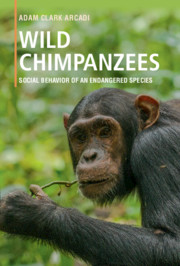Book contents
- Wild Chimpanzees
- Wild Chimpanzees
- Copyright page
- Dedication
- Contents
- Preface
- 1 Primates, Apes, and the Study of Chimpanzee Social Behavior
- 2 Seven Long-Term Field Studies
- 3 Chimpanzee Fission–Fusion Social Organization and Its Conservation Implications
- 4 Sex Differences in Ranging and Association Patterns
- 5 Female Social Relationships
- 6 Male Social Relationships
- 7 Sexual Behavior: Conflicting Strategies of Males and Females
- 8 Coalitionary Lethal Aggression between and within Communities
- 9 Hunting, Eating, and Sharing Meat
- 10 Communication: The Form and Content of Signals
- 11 Community Differences in Grooming Postures and Tool Use: Innovation, Social Learning, and the Question of “Culture”
- Epilogue
- Appendix: Field Methods for Studying Wild Chimpanzees
- End Notes
- References
- Index
- Plate Section (PDF Only)
1 - Primates, Apes, and the Study of Chimpanzee Social Behavior
Published online by Cambridge University Press: 01 June 2018
- Wild Chimpanzees
- Wild Chimpanzees
- Copyright page
- Dedication
- Contents
- Preface
- 1 Primates, Apes, and the Study of Chimpanzee Social Behavior
- 2 Seven Long-Term Field Studies
- 3 Chimpanzee Fission–Fusion Social Organization and Its Conservation Implications
- 4 Sex Differences in Ranging and Association Patterns
- 5 Female Social Relationships
- 6 Male Social Relationships
- 7 Sexual Behavior: Conflicting Strategies of Males and Females
- 8 Coalitionary Lethal Aggression between and within Communities
- 9 Hunting, Eating, and Sharing Meat
- 10 Communication: The Form and Content of Signals
- 11 Community Differences in Grooming Postures and Tool Use: Innovation, Social Learning, and the Question of “Culture”
- Epilogue
- Appendix: Field Methods for Studying Wild Chimpanzees
- End Notes
- References
- Index
- Plate Section (PDF Only)
Summary
The mammalian order Primates includes roughly 500 species, most of which are found in the tropics. As a group, primates are characterized by a constellation of traits that reflect adaptations to arboreal habitats, dietary flexibility, and extensive parental care. Not every trait is present in every species, and when they are present, most traits are expressed to varying degrees in different groups. Nevertheless, all primates possess most or all of the following:
• Flexible and dexterous hands and feet, with flattened nails and sensitive tactile pads on the tips. All species except humans have opposable big toes, and most have opposable thumbs, permitting enhanced grasping ability with both the feet and hands.
• A generalized dentition, typically with four types of teeth, supporting the ability to process a wide range of foods.
• Excellent vision, including the ability to see color, which is absent in other placental mammals.
• Comparatively large brains for their body size, with a longer period of infant and adolescent development, accompanied by an increased role for learning in acquiring social and technical skills.
The order is divided into two suborders, the Strepsirrhini and the Haplorrhini (Figure 1.1). The strepsirrhines include the more “primitive” species,meaning those that appear to resemblemost closely the earliest primate ancestors in body plan and, presumably, behavior. Strepsirrhines have a well-developed sense of smell, eyes that are not completely forward facing and that lack a protective bony socket, and a characteristic form of locomotion called “vertical clinging and leaping.” A large percentage of strepsirrhines are small and nocturnal and do not form permanent social groups. Like many other mammals, most strepsirrhines are seasonal breeders, with females remaining sexually receptive for narrowly limited periods of time each year.
The haplorrhines include the monkeys, the apes, and humans. With the exception of the several owl monkey species (genus Aotus) in Central and South America, haplorrhines are diurnal. They rely greatly on sight, which is reflected in several morphological traits: Their eyes are more forward facing, enhancing depth perception (stereopsis), and are housed in bony sockets. Additionally, their retinas are more sensitive, and they have a comparatively large area of brain cortex associated with visual processing.
- Type
- Chapter
- Information
- Wild ChimpanzeesSocial Behavior of an Endangered Species, pp. 1 - 14Publisher: Cambridge University PressPrint publication year: 2018



